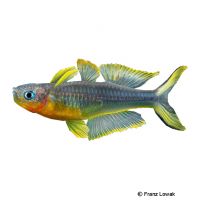Forktail Blue Eye (Pseudomugil furcatus)
| Forktail Blue Eye Pseudomugil furcatus | |
|---|---|
| Name | Forktail Blue Eye |
| Name Lat. | Pseudomugil furcatus |
| Synonym | Popondetta furcata |
| Family | Blue Eyes |
| Family lat. | Pseudomugilidae |
| Order | Silversides |
| Order lat. | Atheriniformes |
| Origin | New Guinea |
| Habitat | Rainforest streams |
| Diet | Omnivore |
| pH | 7.0-8.0 |
| Behavior | Peaceful |
| Keeping | Swarm |
| Care Level | Moderate |
| Reproduction | Egg scatterer |
| Breeding | Moderately difficult |
| Life Span | 2-4 years |
| Protection | No |
| Metric Units | |
| Size | 4.5 cm |
| Temperature | 24-28 °C |
| Hardness | 5-15 °dH |
| Aquarium | 50 l |
| US Units | |
| Size | 1.8" |
| Temperature | 75-82 °F |
| Hardness | 89-267 ppm |
| Aquarium | 15 gal |
Distribution and habitat
Fork-tailed Blueeyes occur exclusively (endemically) in eastern Papua New Guinea, in the coastal lowlands between Dyke Ackland Bay and Collingwood Bay. They live in schools in the clear waters of shallow, slow-flowing forest streams with dense underwater vegetation.
Maintenance
The aquarium should have a dense, varied planting, with shelters and hiding places (roots) and provide sufficient swimming space. A dark substrate of sand or fine gravel, some floating plants (e.g. Rizzia) and clear, slightly alkaline water as well as a weak current is ideal.
No ammonia, ammonium and nitrite should be detectable, the nitrate value should not exceed 100 mg/l. To ensure the water quality and oxygen content, a filter and heater adapted to the aquarium size is required, as well as lighting for the species-appropriate day-night rhythm of the animals.
Diet
The food supply consists of small live food, which is also accepted without problems in frozen form, such as Artemia, Moina, Daphnia and mosquito larvae or a commercially available frozen nano food mix. In addition, they need regular vegetable food in the form of granulated or flake food for nano fish with spirulina or kelp
It is recommended to feed small portions twice a day. Regular and varied feeding promotes health and prevents deficiency symptoms. Only feed as much as is eaten immediately (in a maximum of 10 minutes).
Behaviour and compatibility
They are lively, swimming swarm fish and at least 5, but preferably much more should be kept together, whereby the number of females should predominate. In the shoal the males show their most beautiful coloration. These very peaceful fish can be socialized well with other calm and small fish (nano fish) as well as shrimps
Basically, only compatible fish species with similar demands on water conditions and water temperature should be socialized.
Sex dimorphism
The females are not as intensely colored as the larger males, which have an extended first dorsal fin.
Reproduction and breeding
They are free spawners, which during the reproductive period daily in the morning (morning sun) deposit their eggs, which are provided with adhesive threads, on fine-leaved plants. The fry hatch after 15-20 days. The parents are spawn predators.
Fry must be fed several times a day with special rearing food (dust food, Artemia nauplii, infusoria). In community tanks breeding is hardly possible, because the spawn is easy prey.
Important
They like to jump, so the aquarium should be well covered
Occasionally they are confused with the closely related Popondetta blueeyes (Pseudomugil connieae), but they have 10-12 segmented rays in the second dorsal fin and their males are colored yellow on the chest.
The well-being of the fish should be checked regularly. Temperature should be checked daily, pH, hardness and nitrate levels should be checked at least every 14 days. Regular partial water changes are recommended, even if the contaminant level has not yet reached the upper limit. Sudden changes in water quality should be avoided. Newly introduced fish must be accustomed slowly to the water in the aquarium.
Further literature can be found in your pet store.
References
Text: Werner Winter; Image: Franz Lowak
Source: BMELV (1998): Tierschutzgutachten - Haltung von Zierfischen (Süßwasser); BAENSCH & RIEHL (2004): Aquarien Atlas Bd. 2, Mergus Verlag; ENGELMANN (2005): Zootierhaltung - Tiere in menschlicher Obhut: Fische, Verlag Harri Deutsch
- Gemäß § 21 Abs. 5 Tierschutzgesetz idgF
